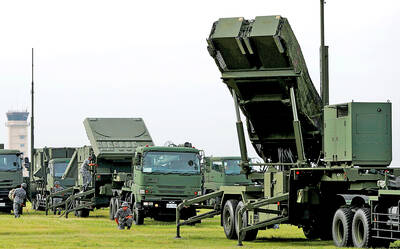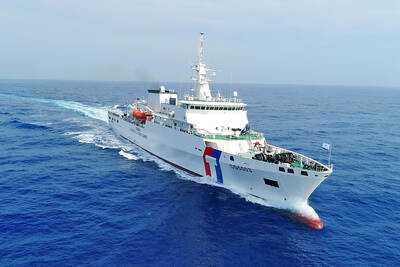The pressure is increasing on Lehman Brothers Holdings Inc to come up with a plan to restore itself to financial health — or possibly face the worst-case scenario of selling itself off in pieces and at bargain prices.
The nation’s fourth-biggest investment house is considered the most vulnerable amid the financial sector’s continuing losses from the credit crisis.
This week, Lehman has been the subject of analyst downgrades and projections that it will lose US$4 billion in the third quarter. There is rising speculation — most of it negative — about its short-term prospects, leading more investors to bail out of Lehman stock, which closed on Wednesday at US$13.73, well off its 52-week high of US$67.73.
Lehman needs to come up with a plan to purge itself of its risky mortgage-backed assets and raise new capital. But neither task is easy: Prospective buyers for those assets want to pay as little as they can get away with and the big offshore investors that invested in Citigroup Inc and Merrill Lynch & Co months ago are wary about sinking more money into the financial industry.
What makes the situation harder for Lehman chief executive Richard Fuld is that Wall Street is still smarting from the near-collapse of rival Bear Stearns & Co in March.
“If people think they [Lehman] are heading toward bankruptcy, nobody will want to do business with them or make them new loans. That’s Fuld’s biggest problem,” said Richard Sylla, financial historian and economist at New York University’s Stern School of Business.
Fuld, who took the company public in 1994 after splitting it off from American Express Co, is said to be considering the sale of all or part of Lehman’s investment management arm. That includes the highly profitable money manager Neuberger Berman, which it bought for US$2.6 billion in 2003.
That business, with about US$277 billion under management, could fetch between US$7 billion and US$13 billion, analyst reports said. It would be the latest move by Wall Street to sell off assets, including last month’s sale by Merrill Lynch & Co of its stake in news and data provider Bloomberg LP.
Buyers could potentially include large private equity firms, which were among the bidders for Bear Stearns before it was taken over by JPMorgan Chase & Co.
A spokeswoman for Lehman Brothers declined to comment about a possible sale of the division.
Another option for Lehman is to secure funding from a sovereign wealth fund or another big institution. However, reports that a deal to raise US$5 billion from South Korean investors fell through points to the caution among potential investors.
“They are clearly not as keen on investing in the financial sector until the credit crisis plays out,” said Elisa Parisi, lead finance and banking analyst for RGE Monitor. “Selling off assets would be at fire-sale prices — and investors will bark if you try and sell some of the crown jewels of the company.”
Global banks and brokerages have been forced to raise new capital after writing down more than US$300 billion of mortgage-backed securities and other risky investments in the past 12 months. Lehman currently has more than US$60 billion of exposure to real estate and mortgage-backed securities.
Many of Lehman’s troubled assets still have value, but the firm can’t sell them because the market is just about paralyzed. It’s likely that the only way to get the investments off Lehman’s books is to sell them at a steep discount, much as Merrill Lynch did last month when it sold risky assets for US$0.22 on the dollar.
“We anticipate that Lehman will reduce its overall mortgage exposure by 20 percent, suggesting about a US$15 billion reduction,” Goldman Sachs analyst William Tanona said in a note to clients.
Though Lehman won’t get much for the sales, analysts like Tanona believe that such a drastic step will help rid the bank of perceptions it is loaded with heavy risk.
If Lehman can also raise enough capital, the moves will “buy them some time and allow them to emerge from the crisis and rebuild,” Parisi said.
However, with the market changing so quickly, any missteps by Fuld could cost him not only the CEO job but the entire company.
Selling off profitable pieces of Lehman might raise capital, but would hurt long-term profitability.
And there is also the possibility that Fuld might consider selling the company, possibly to a retail bank that has little exposure to turmoil in the credit markets.
“The finance sector needs massive consolidation,” Merrill Lynch strategist Rich Bernstein said in a report. “There is simply too much lending capacity in the global economy.”

MILITARY BOOST: The procurement was planned after Washington recommended that Taiwan increase its stock of air defense missiles, a defense official said yesterday Taiwan is planning to order an additional four PAC-3 MSE systems and up to 500 missiles in response to an increasing number of missile sites on China’s east coast, a defense official said yesterday. The official, who spoke on condition of anonymity, said that the proposed order would be placed using the defense procurement special budget, adding that about NT$1 trillion (US$32,88 billion) has been allocated for the budget. The proposed acquisition would include launchers, missiles, and a lower tier air and missile defense radar system, they said The procurement was planned after the US military recommended that Taiwan increase

POLITICAL AGENDA: Beijing’s cross-strait Mid-Autumn Festival events are part of a ‘cultural united front’ aimed at promoting unification with Taiwan, academics said Local authorities in China have been inviting Taiwanese to participate in cross-strait Mid-Autumn Festival celebrations centered around ideals of “family and nation,” a move Taiwanese academics said politicizes the holiday to promote the idea of “one family” across the Taiwan Strait. Sources said that China’s Fujian Provincial Government is organizing about 20 cross-strait-themed events in cities including Quanzhou, Nanping, Sanming and Zhangzhou. In Zhangzhou, a festival scheduled for Wednesday is to showcase Minnan-language songs and budaixi (布袋戲) glove puppetry to highlight cultural similarities between Taiwan and the region. Elsewhere, Jiangsu Province is hosting more than 10 similar celebrations in Taizhou, Changzhou, Suzhou,

TWO HEAVYWEIGHTS: Trump and Xi respect each other, are in a unique position to do something great, and they want to do that together, the US envoy to China said The administration of US President Donald Trump has told Chinese President Xi Jinping (習近平) “we don’t want any coercion, but we want [the Taiwan dispute] resolved peacefully,” US ambassador to China David Perdue said in a TV interview on Thursday. Trump “has said very clearly, we are not changing the ‘one China’ policy, we are going to adhere to the Taiwan Relations Act, the three communiques and the ‘six assurances’ that were done under [former US president Ronald] Reagan,” Perdue told Joe Kernen, cohost of CNBC’s Squawk Box. The act, the Three Joint Communiques and the “six assurances” are guidelines for Washington

DEEPENING TIES: The two are boosting cooperation in response to China’s coercive actions and have signed MOUs on search-and-rescue and anti-smuggling efforts Taiwan and Japan are moving to normalize joint coast guard training and considering the inclusion of other allies, the Japanese Yomiuri Shimbun reported yesterday. Both nations’ coast guards in June sent vessels to the seas south of the Sakishima Islands to conduct joint training, the report said, adding that it was the second joint maritime training exercise since the nations severed formal diplomatic ties in September 1972. Japan dispatched the Nagoya Coast Guard’s Mizuho, a 134m, 6,000-tonne patrol vessel which can carry a helicopter, while the Coast Guard Administration (CGA) sent the 126m, 4,000-tonne Yunlin, one of its largest vessels, the report